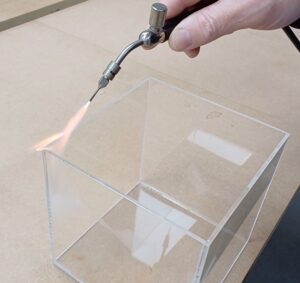Ash Plastics, we are often asked about the different polishing methods available for acrylic products. In this blog post, we will answer some of the most frequently asked questions about flame, diamond and mop polishing.
What is flame polishing?
Flame polishing is a process that uses a carefully controlled flame to melt the surface of the acrylic. This creates a smooth, polished finish that is free of imperfections.
What are the advantages of flame polishing?
Flame polishing is a fast and efficient process that can be used to polish large areas of acrylic. It is also a relatively inexpensive method.
What are the disadvantages of flame polishing?
Flame polishing can only be used on certain types of plastics. It is also important to use the correct flame temperature and distance to avoid damaging the material.

What is diamond polishing?
Diamond polishing is a process that uses a diamond-tipped tool to polish the surface of the acrylic. This creates a very high-quality finish that is even smoother than flame polishing.
What are the advantages of diamond polishing?
Diamond polishing can be used on a wider range of plastics than flame polishing. It also produces a more consistent finish.
What are the disadvantages of diamond polishing?
Diamond polishing is a more expensive process than flame polishing. It also requires more specialized equipment.

What is mop polishing?
Mop polishing is a process that uses a buffing wheel and polishing compound to polish the surface of the acrylic. This creates a high-gloss finish that is similar to diamond polishing.
What are the advantages of mop polishing?
Mop polishing is a less expensive process than diamond polishing. It can also be used to polish a wider range of plastics.
What are the disadvantages of mop polishing?
Mop polishing can produce a less consistent finish than diamond polishing. It also requires more skill and experience to achieve a good result.
Which polishing method is right for me?
The best polishing method for you will depend on your specific needs and budget. You may be looking for a fast and inexpensive method, then flame polishing is likely a good option. If you need a very high-quality finish, diamond polishing is the best choice. You may be limited to a budget, then mop polishing may be a good compromise.
In addition, here are some other frequently asked questions about polishing:
- Can I polish acrylic at home?
Yes, you can polish acrylic at home. However, it is important to use the correct tools and techniques.
- What type of polishing compound should I use?
There are many different types of polishing compounds available. It is important to choose a compound that is designed for the type of acrylic you are polishing.
- How do I know when my acrylic is polished enough?
Once you are happy with it, it is ready! When the surface of the acrylic is smooth and shiny, it is polished enough.
- Can I polish acrylic that has been scratched?
Yes, you can polish acrylic that has been scratched. However, it is important to use a fine-grit polishing compound to avoid damaging the acrylic.
We hope this blog post has answered all of your questions about polishing acrylic and other plastics. If you have any further questions, or you are looking for a competitive quotation, then please do not hesitate to contact us:
Tel: 01902 450300
Email: Hello@ashplastics.co.uk
You can find out more about us here, and more about our polishing methods here: https://www.ashplastics.co.uk/plastic-forming-and-fabrication/acrylic-polishing/


